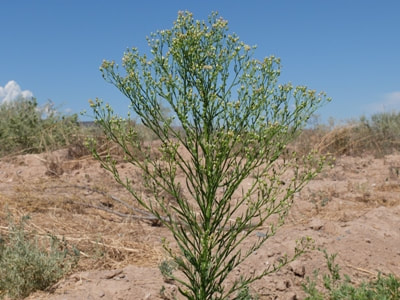|
Found in disturbed soil
Seen blooming in August by CR 142, Abiquiu This common annual weed grows from two to seven feet tall, making it hard to miss. It is identifiable by its solitary, upright, leafy stem which ends in a many-branched flower head of numerous tiny white and yellow flowers. The leaves are long and narrow becoming smaller as they ascend the stem. If you look closely at the flowers you will see that they have rays, though the white ray petals are only about 1 mm long. Although rather uninteresting in appearance Horseweed has many traditional uses. Young leaves and seedlings are edible. Dried leaves can be used as a seasoning with a tarragon-like flavor. An essential oil is used to flavor candy, condiments and soda. Horseweed was boiled to make steam for sweat lodges, taken as a snuff to stimulate sneezing during the course of a cold and burned to create a smoke that warded off insects. It is said to be a very effective treatment for bleeding hemorrhoids. A tea from the leaves was used to treat dysentery and a tea from the boiled root for menstrual issues. Horseweed has also been called Fleabane because the leaves put in pet’s beds help to get rid of fleas. Source. If you are trying to identify a different flower, then you can check what other flowers bloom this month. If you cannot identify a flower from the website send a photo and where you took it to [email protected]. Read online for tips.
0 Comments
Leave a Reply. |
AuthorI am Marilyn Phillips, a native of England, whose love of nature and the outdoors from childhood brought me by a circuitous route to Crested Butte, Colorado in 1993 and 16 years later to northern New Mexico. My exploration of the many trails in these areas, my interest in wildflowers and photography, and career in computer system design came together in this creation. If you have any corrections, comments or questions, please contact me by email. Archives
September 2025
Categoriescopyright © 2020
|



 RSS Feed
RSS Feed